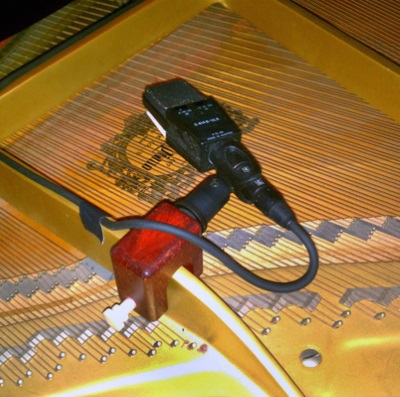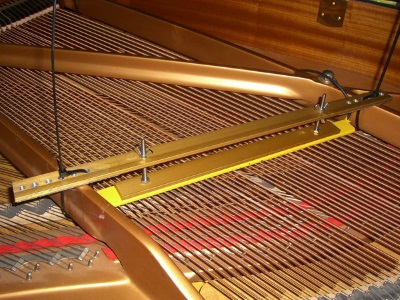
Getting Creative
Some venues are particular about tape on their pianos. When visiting the White House East Room with Tony Bennett and opening its Mahogany Steinway, I was sternly informed that no tape was to be used.
I pointed out that there was an awful lot of tape residue on the piano for that to be true, but was told it was “historical.”
Another approach to mounting closed-lid piano mics was introduced to me by Greg Grecco: hardwood blocks with a notch cut out and a threaded mic clip flange. Fitting the blocks over the piano harp struts allows mics to be mounted and removed in a minute.
The Audix SCX-25A-PS is a matched pair of the company’s LDC “lollipop mics” that come with small gooseneck clips for attachment to harp struts. These clips can be bought separately as well. There are also several Atlas clamp options that can be used to attach a mic clip to struts.
The DPA 4099P mic kit employs a magnet to hold a short, skinny gooseneck to any part of the piano’s iron harp frame, allowing mics to be easily attached and quickly adjusted for optimal positioning. The DPA SMK4061 stereo mic kit also provides a variety of mounting accessories for placement in and on the piano, with either an open or closed lid.

Even with the lid closed, sound sources near the piano will get into the mics inside, coming in from the sides, the top, and up through the sound board underneath. A trick employed at several European jazz festivals simply borrows recording studio “gobos” or sound baffles to isolate the piano.
In lieu of these, I use the pair of empty road cases from the bass rig’s 4 x 10 cabinets, placed upstage of the piano (and out of sight) to block sound, beefed up with a packing blanket and covered with Duvetyne (twill fabric with a nap on one side).
Picking Them Up
Even with all of these tricks, piano mics often can’t be used in floor monitors due to lack of isolation and gain before feedback, leading to the use of a piano pickup.
The dry, boxy sound of a piano pickup and the piano’s wooden resonance requires lots of low-mid EQ. Rational Acoustics Smaart Tools on an iPhone and an iPad-controlled monitor desk are very helpful.
The original Helpinstill pickups were a set of six magnetic bars that were mounted beneath the strings to pick up their vibrations in the same way as an electric guitar pickup, providing an “electric” sound that doesn’t sound natural but helps in the monitors. Engineers often used the six bars with a small mixer onstage to reduce channel count and better balance and pan them to a stereo output.

Helpinstill’s newer Model 180 is comprised of three larger, different-sized magnetic bars that are better suited for the geometry of grand pianos, with two that sit below the mid and high sections and a third that suspends over the low strings.
Though supplied with a three-channel passive combiner, using individual DIs to bring them into three console channels allows engineers to balance and EQ them individually. Some supplement with only the low bar to make up for low-mid EQ that usually gets cut from mics in a closed lid piano.
The Barcus-Berry Model 4000 planar wave transducer is a piezoelectric pickup with feet. It’s supplied with a preamp, but experienced users employ a Countryman Type 10 DI that’s well matched to this high-impedance transducer. It’s feet attach with tiny squares of double-side tape to the piano’s soundboard, with many preferring placement in one of the sound holes.
Schertler is a Swiss company that makes a variety of instrument pickups, but is best known for the DYN P piano pickup, which attaches to the soundboard, often in a sound hole, with reusable putty.
